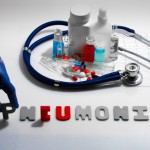What if there was a way to treat a deadly pneumonia without antibiotics? What if you could treat it with a blood thinner?
Researchers at the University of Pittsburgh have found that the destructive actions of a protein leading to lung cell death can be blocked by argatroban, a medication that is used as a blood thinner in clinical practice. Better still is the dose required to achieve this effect is well below that needed for thinning the blood meaning it does not carry with it the expected risk of bleeding.
The study, published in Science Translational Medicine, describes the role of Morf4l1, a cytotoxic protein (causing cell death) that's found in lung tissue, which plays an important role in the significant damage caused by pneumonia, specifically by the deadly bacteria known as Pseudomonas aeruginosa. Morf4l1 is a multifunctional protein that modulates a cell s ability to survive and develop, as well as DNA repair.
In preclinical studies, the authors found an increased amount of Morf4l1 in lung tissue that had been exposed to Pseudomonas. Researchers observed when Morf4l1 was overexpressed in cells there was a concomitant increase in lung cell death. Conversely, when they depleted cells of this protein, there was improved cell survival under the same conditions.
In computer simulation models, researchers found that argatroban tightly binds to this protein and selectively blocks Morf4l1 s cytotoxic activity. When treated with argatroban, mice with Acute Lung Injury (ALI) caused by Pseudomonas infection suffered less severe lung tissue damage and had improved survival rates. This suggested that as a repurposed drug, argatroban had the ability to preserve lung tissue in the face of inflammation and infection by blocking the actions of Morf4l1.
When infected with Pseudomonas, Morf4l1 triggered cell death by sending signals to the infected cells to commit suicide and die (aka apoptosis and necrosis). When a mutation was introduced into the protein rendering it inactive, more lung cells survived even though they were infected with Pseudomonas. When a mutation led to more Morf4l1, increased lung cell death was observed. Fluid from the lungs of mice lungs that were treated with argatroban showed a significantly reduced activity of Morf4l1 and a marked increased of survival.
This research could have profound effects clinically as Pseudomonas aeruginosa is associated with severe hospital-acquired infections, especially in those who are immune compromised. In many it is seen as a death sentence. Antibiotic resistance is not uncommon which complicates the ability to treat the infection, ultimately resulting in more death.
Pseudomonas pneumonias are the most common cause of hospital-acquired pneumonias, as most are associated with the use of ventilators. Studies have shown that the following are associated with higher probability of nosocomial infections with this bug:
- Older age
- Duration of mechanical ventilation
- If any antibiotics were given at admission
- Transfer from a medical ward to an ICU
- Admission to a ward with higher rates of Pseudomonas
It is very rare to see acquired Pseudomonas infections in the community except in those with compromised immune systems (i.e. HIV, transplant patients on immunosuppressive therapy, recent/prior antibiotic use, Cystic Fibrosis, COPD).
Infections with this particular bug can cause significant structural lung damage by abscess formation, with bleeding and necrosis leading to high mortality rates and prolonged hospitalizations. Drug resistance complicates the treatment of this infection and consultation with an infectious disease specialist is warranted.
As with any other potential treatment, further research is required before human trials can begin. The exact mechanism of action of argatroban s effect on Morf4l1 needs to be elucidated.
In light of increased drug resistance, the ability to introduce novel therapies not involving antibiotics, makes argatroban that much more appealing. Even with antibiotic treatment considerable tissue damage can occur resulting in the destruction of the architectural integrity of the lung. Argatroban may provide a pathway to preserve lung tissue and ultimately improve the survival of those infected with the deadly Pseudomonas bacteria.




